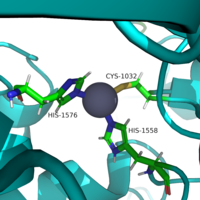User:Asif Hossain/Sandbox 1
From Proteopedia
(Difference between revisions)
| Line 1: | Line 1: | ||
=Histone Deacetylase 8 (HDAC 8)= | =Histone Deacetylase 8 (HDAC 8)= | ||
| + | |||
== Introduction == | == Introduction == | ||
Histone deacetylase 8 (HDAC 8) is an enzyme that plays a role in controlling gene expression. Specifically, it catalyzes the removal of an acetyl group off of the ε-amino-lysine sidechain of N-terminal core of Histone proteins. By removing the acetate ion, the reclaimed positive charge on the lysine sidechain is able to interact with the negative charge on the DNA. As a result, DNA will bind more tightly to the histone protein reducing transcription and expression. | Histone deacetylase 8 (HDAC 8) is an enzyme that plays a role in controlling gene expression. Specifically, it catalyzes the removal of an acetyl group off of the ε-amino-lysine sidechain of N-terminal core of Histone proteins. By removing the acetate ion, the reclaimed positive charge on the lysine sidechain is able to interact with the negative charge on the DNA. As a result, DNA will bind more tightly to the histone protein reducing transcription and expression. | ||
| Line 5: | Line 6: | ||
====Histones==== | ====Histones==== | ||
====Acetylation==== | ====Acetylation==== | ||
| - | ====Reverse Reaction (HATs)==== | ||
<StructureSection load='2v5w' size='340' side='right' caption='Caption for this structure' scene=''> | <StructureSection load='2v5w' size='340' side='right' caption='Caption for this structure' scene=''> | ||
| + | |||
| + | ==Homology== | ||
| + | |||
| + | ==Structural Highlights== | ||
==Mechanism== | ==Mechanism== | ||
| Line 12: | Line 16: | ||
<scene name='81/811085/Active_site/4'>Active Site</scene> | <scene name='81/811085/Active_site/4'>Active Site</scene> | ||
| - | |||
| - | == Disease == | ||
== Relevance == | == Relevance == | ||
Revision as of 18:32, 2 April 2019
Contents |
Histone Deacetylase 8 (HDAC 8)
Introduction
Histone deacetylase 8 (HDAC 8) is an enzyme that plays a role in controlling gene expression. Specifically, it catalyzes the removal of an acetyl group off of the ε-amino-lysine sidechain of N-terminal core of Histone proteins. By removing the acetate ion, the reclaimed positive charge on the lysine sidechain is able to interact with the negative charge on the DNA. As a result, DNA will bind more tightly to the histone protein reducing transcription and expression.
Function
Histones
Acetylation
| |||||||||||

